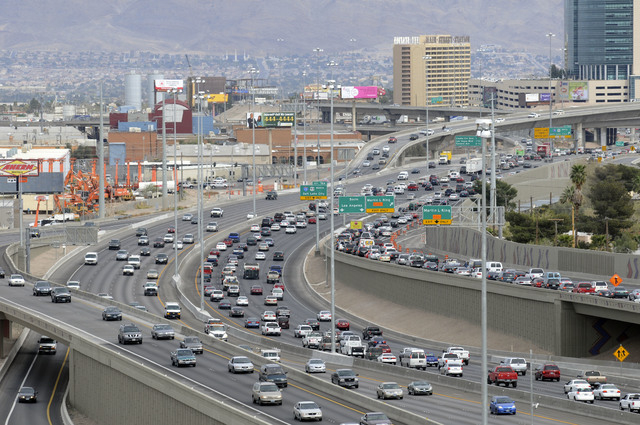How do Clark County street projects get built?
By now, anybody who cares about the condition of our roads and highways wonders when our local government entities are going to get around to a particular street or traffic signal project.
They might want to know more about something called “fuel revenue indexing.”
To Clark County, its municipalities and the Regional Transportation Commission of Southern Nevada, it means more money for local projects and an opportunity to catch up on infrastructure work that went by the wayside during the Great Recession.
To motorists, it means forking over a few more pennies per gallon of gasoline at the pump, an amount that, as we all know, turns into dollars over time.
Southern Nevada’s government entities are quick to publicize when one of their projects is funded, at least in part, by fuel revenue indexing dollars.
The first indexing project to break ground was an overpass of the 215 Beltway near Fort Apache Road and Centennial Parkway in April.
Since then, there have been plenty more.
The proposed Interstate 11 project carries a high priority with the Nevada Transportation Department so indexing funds are being used for the state’s portion of the project, the Boulder City bypass project.
After hearing neighborhood complaints about traffic around the new Wet ‘n’ Wild water park and safety concerns for students crossing streets at nearby Wilbur and Theresa Faiss Middle School, the county announced plans for two traffic signals, one of which has already been completed and activated.
The city of Las Vegas is in the midst of major downtown street overhaul, building one-way pairs for Main and Commerce streets and using indexing funds.
North Las Vegas launched four different projects in June, including large chunks of Simmons Street, Losee Road and a pedestrian bridge over Losee.
Henderson announced three projects late last month that will improve traffic flow and provide bicycle lanes on three busy streets, Warm Springs Road, Eastern Avenue and Whitney Ranch Drive.
Even smaller Clark County communities have access to the funding. Mesquite, for example, looks to build a new exit off Interstate 15 south of town to provide access to a growing industrial area.
In all, 199 projects are forecast to be built from the beginning of the indexing program in January to its planned end in December 2016. The Regional Transportation Commission frequently says that without indexing, Clark County would be limited to building one interchange per year, one mile of roadway per year in each jurisdiction or one beltway segment without bridges per year. With indexing, local entities would have the bonding capacity to build $700 million worth of projects — and that’s key to understanding exactly how a project concept becomes a functioning piece of infrastructure.
Mike Hand, director of engineering services for streets and highways at the Regional Transportation Commission, and Marc Traasdahl, director of finance for the commission, explained that the process begins at the local level with public works directors gauging the needs of their communities. Those decisions are guided by public input and policy decisions through planning commissions and city councils.
“They’re the ones who know what’s going on in their cities,” Traasdahl said.
The commission compiles a list of projects from each municipality that includes a description of the project and an estimated cost.
Municipal public works directors sit on an executive advisory committee that places emphasis on widening, safety, lighting and freeway technology projects that could be beneficial to multiple jurisdictions.
Meetings are cordial and there are occasional debates on which projects are most beneficial.
“We have healthy disagreements once in awhile, but everybody stays very professional and knows how the world works,” Hand said.
There are several revenue sources, most of which lead back to the taxpayer’s pocket. Locally, sales taxes are a revenue source. Statewide, motor vehicle fuel taxes generate a Nevada fund while federal fuel and road taxes build federal funds.
Sometimes, a federal grant is dependent upon matching local funds which is why local governments try to build their own funds to enable them to access more money.
Most often, municipalities borrow money to build large projects with bonds that work much like a home mortgage. The indexed funds secure the bonds that are purchased based on the life expectancy of a project. In most cases, that’s 20 years in Nevada, but it’s not uncommon to build a Nevada project with a 20-year life expectancy that lasts longer thanks to concrete highway surfaces.
Fuel indexing originated at the state level when legislation was drafted enabling county commissions to participate in the plan. The Clark County Commission voted to opt in. Originally, motorists paid 3.25 cents per gallon, but the fund is indexed to producer prices, meaning that if the economy improves and producer prices go up, so does the tax.
In June, the index rose 6.05 percent from a year ago, which meant the price at the pump went up an additional 3.35 cents. It stands at 6.6 cents per gallon and it can’t go any higher than 10 cents a gallon.
It’s possible for the tax rate to go down in the next 2½ years indexing in effect, but that’s highly unlikely considering that the producer price index is calculated on a rolling 10-year rate and prices have risen steadily in the last decade. It would take consecutive years of downturns for the trend to reverse.
Is the public getting enough bang for its buck with indexing? It will get to weigh in with the 2016 fall election. Voters will decide in November that year, during the presidential election, whether it wants to continue the indexing plan.
Local municipalities are hoping you think it’s worth the investment and that’s why you’ll continue to reminded whenever a project is built with fuel indexing funds.

















